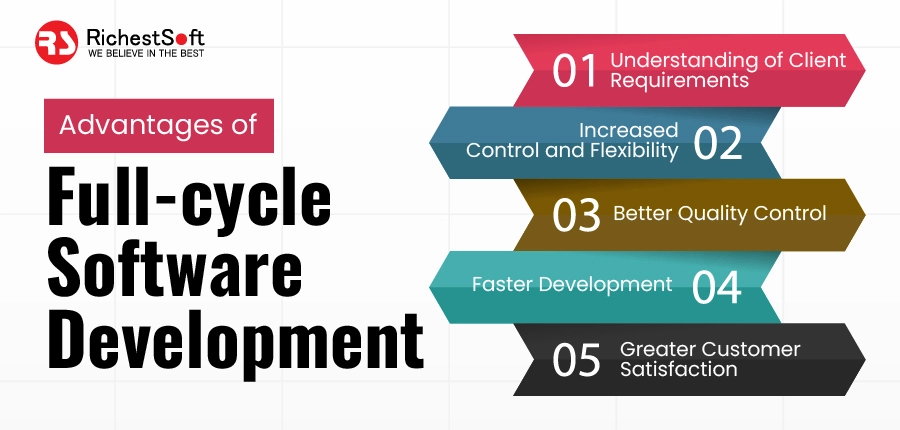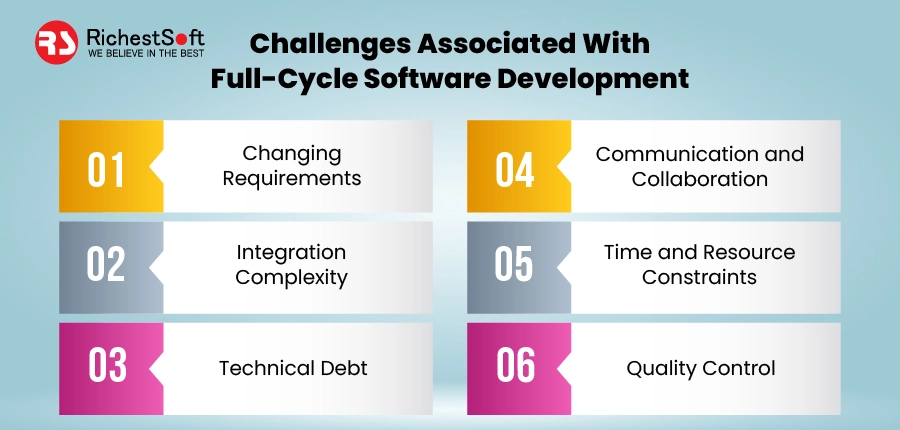Here you will find comprehensive information about creating software from the start. This post will guide you from the first idea to the final deployment, regardless of whether you are an experienced developer or just starting. From selecting the appropriate technologies and tools through testing and maintenance, we’ll go over it all. So, quickly learn how to create top-notch software that meets industry standards.
What is Full-Cycle Software Development?
The full-cycle software development method includes the complete procedure of creating and releasing software. It covers everything from the initial conceptualization and analysis through the final stages of implementation and maintenance. With the help of this technique, programmers can more reliably satisfy customer expectations and stick to project deadlines and budgets.
By dividing large projects into manageable chunks, team members can better work together on the complete cycle model. It also facilitates rapid response to shifting customer demands and technological developments by providing a mechanism for continual improvement through feedback loops and iterative development cycles.
Full-cycle software development may achieve efficient delivery of solutions that meet users’ functionality, reliability, maintainability, and scalability needs.
What are the Advantages of Full-Cycle Software Development?

Compared to outsourcing or partial development, full-cycle software development has several advantages. Key advantages include the following:
✅A better understanding of client requirements:
Client involvement spans the life cycle of full-cycle software development. Therefore, the software development team may work more effectively toward meeting the client’s needs, wants, and expectations.
✅Increased control and flexibility:
When it comes to software, having complete control over the whole process, from requirements collecting to deployment, is essential. Because of this, they can make necessary modifications to the project when conditions or requirements shift.
✅Better quality control:
It is via full-cycle software development that defects may be appeared and fixed before they majorly affect the final product. The outcome is a high-quality, dependable item that exceeds expectations.
✅Faster development and deployment:
Full-cycle software development allows for speedy development and deployment by fostering greater efficiency and client-team collaboration.
✅Greater customer satisfaction:
Full-cycle software development ensures the end product exceeds all expectations and delights clients, leading to higher customer satisfaction.
Full-cycle software development has several benefits that can lead to happier customers and a higher-quality final product.
What are the Steps Included in a Complete Software Development Life Cycle?

It takes several steps in the software development life cycle to produce a working piece of software. Familiar phases of a software development life cycle include:
👉Planning and Analysis: The client and software development team define the project’s scope, objectives, and requirements. Understand your users, company, and technology.
👉Design: The software’s user interface, database design, and overall system architecture are all created by architects and designers at this stage.
👉Development: Here, developers create the software by implementing the planned features specified in the design phase.
👉Testing: The program is tested at this point to ensure it can carry out its intended functions. It includes testing at the unit, integration, system, and acceptance levels.
👉Deployment: Deployment occurs once testing is complete and the program is ready for usage in a live setting.
👉Maintenance and Support: At this stage, we monitor the code to ensure nothing goes wrong. Continuity entails attending to software issues, answering technical questions, and releasing updates as required.
In full-cycle software development, each stage is crucial and builds on the one before. A systematic and organized approach to full-cycle software development may assist in guaranteeing that the software is created quickly, successfully, and by the needs and expectations of the customer.
Tools and Technologies for Full-Cycle Software Development

Full-cycle software development may benefit from process-streamlining various tools. Just keep an eye on the below-described tools –
✔️Integrated Development Environments (IDEs):
By offering a unified setting to create, test, and debug software, Integrated Development Environments (IDEs) save time and effort during the development process.
✔️Version Control Systems (VCS):
Version control systems (VCSs) are software components that catalog a program’s iterations. Git, Subversion (SVN), and Mercurial are popular to use VCSs.
✔️Project Management Tools:
Project management tools aid in the planning, scheduling, and tracking of software development. Popular project management tools include Jira, Trello, and Asana.
✔️Testing Frameworks:
Using a testing framework, you may automate your unit tests, integration tests, and system tests. JUnit, NUnit, and Selenium are examples of commonly used test frameworks.
✔️Continuous Integration/Continuous Deployment (CI/CD) Tools:
The automation of the whole software development life cycle is possible with CI/CD tools. Jenkins, Travis CI, and CircleCI are examples of well-liked CI/CD tools.
✔️Cloud Computing Platforms:
With cloud computing, coded in any language may be deployed and run. Microsoft Azure, Google Cloud Platform, and Amazon Web Services are popular cloud services.
Challenges Associated With Full-Cycle Software Development

Several obstacles might arise during full-cycle software development that the development team must overcome. Some of the most typical problems that crop up during software development life cycles include:
👉Changing Requirements: As the project progresses, the client’s needs may evolve, resulting in delays and needing to revise the software’s architecture and development methodologies.
👉Integration Complexity: It might be inappropriate to integrate many software parts, especially if separate people or companies created them.
👉Technical Debt: A software project’s “technical debt” is the sum of all the money that has to be spent to correct bugs and other issues caused by things like sloppy coding, outdated libraries, and a lack of thorough documentation. Long-term, technical debt might impede the program’s ability to stay secure and current.
👉Communication and Collaboration: Communication and collaboration with customers and stakeholders are crucial to a software development project’s success. Keep everyone informed of project progress by communicating and meeting often.
👉Time and Resource Constraints: Completing the entire software development cycle requires much time, effort, and money from software developers. These constraints may lead to delays, compromised quality, and increased costs.
👉Quality Control: Full-cycle software development has significant difficulties in ensuring software quality. Having quality assurance measures in place during development allows for issues to be addressed as soon as they are uncovered.
Overcoming these challenges requires careful preparation, clear communication, and the application of helpful tools and procedures. Full-cycle software development projects may be completed on time, within budget, and to the satisfaction of the client if the development team can adequately manage these issues.
How to Select a Full-Cycle Software Development Company

Your software development project’s success depends on choosing a full-cycle software development business. The following are factors to consider while choosing a software development company:
✅Experience and Knowledge:
Look for a company with experience with the tools and processes needed for your software development project. Verify their previous similar project completions by checking their portfolio and references.
✅Development Methodologies:
Select a business whose software development approach matches your objectives for the project. Popular methods for developing software include Agile and Scrum.
✅Collaboration and Communication:
The team’s capacity for both is crucial to the success of any software development project. Pick a firm whose project management and communication methods are open and interactive.
✅Technical Capabilities:
If you need custom software developed, tested, and deployed, your best bet is a firm with a capable technical staff. Verify if they are employing up-to-date development frameworks and tools.
✅Quality Assurance:
For every software development project to be successful, quality assurance is implemented. You should engage a business with a rigorous quality assurance procedure to know that the software is developed and tested to your standards.
✅Costing and Agreements:
Find an organization with words that are easy to comprehend, adaptable, and can be adjusted as needed. Find out if they provide a variety of payment alternatives, such as hourly rates, fixed prices, and time and materials billing, so that you may select the most appropriate payment mode for the task at hand.
✅Support and Maintenance:
Find a company that offers support and maintenance for their software after deployment. Check their history of solving problems and responding quickly before hiring them.
Considering these will help you select a full-cycle software development firm that can provide a software solution that lives up to your highest standards.
Tips for Successful Full-Cycle Software Development Projects

Full-cycle software development initiatives must be meticulously planned and carried out to succeed. Here are some suggestions for completing a software development project successfully from start to finish:
✔️Define clear project goals and requirements:
Starting with the customer, stakeholders, and development team, define the project’s explicit goals and needs. Ensure you and your team have the same expectations and approach for the project.
✔️Pick the correct development methodology:
Choose a software development strategy that fits the needs and goals of your project. Software development initiatives frequently choose Agile and Scrum techniques.
✔️Focus on communication and collaboration:
The team’s capacity to communicate and work with customers and other stakeholders is crucial to the success of a software development project. To keep everyone informed, keep communication open and hold frequent meetings.
✔️Prioritize quality assurance:
For every software development project to be successful, quality assurance is required. Make sure solid quality assurance methods are in place to catch problems early on and fix them efficiently.
✔️Use modern development tools and technologies:
Increase productivity and quality in software creation using today’s available development tools and technologies. Make sure the development team is using cutting-edge software and hardware.
✔️Test early and often:
The software development life cycle must always include testing. If problems are not found and fixed early on, they will only worsen and cost more to cure later.
✔️Manage risks proactively:
Determine what difficulties and threats might affect the project and create a strategy to deal with them.
✔️Emphasize user experience:
Ensure the end user’s needs are considered during the program’s development. Contact the intended audience and ask about their needs and wants.
Following these guidelines will considerably improve your chances of delivering a software development project the client likes.
FAQs
Q1: What are the benefits of full-cycle software development?
Ans: Full-cycle software development lets you customize a product from start to end. Full-cycle development lets you manage product schedule, cost, and quality while minimizing outsourcing risks. Prepare to build a software solution that grows with your business.
Q2: What are the major stages of full-cycle software development?
Ans: Requirements gathering, design, development, testing, deployment, and maintenance are the usual core steps in full-cycle software development. The development team’s technique and approach will determine the precise stages.
Q3: How do you choose a full-cycle software development company?
Ans: Selecting a full-cycle software development business requires skills, experience, development methodology, communication and collaboration practices, technical capabilities, quality assurance procedures, pricing, contractual models, support and maintenance services, etc.
Q4: How do you ensure the success of a full-cycle software development project?
Ans: An agile methodology is the foundation of any successful software development project. To do so, one must establish attainable objectives and time frames, assemble a competent team, and equip them with collaboration tools that improve communication and keep everyone aware of developments.
Q5: How do you manage changes during full-cycle software development?
Ans: A change management approach is essential for managing changes throughout full-cycle software development. This process should include steps like determining the extent of the change, informing the appropriate parties, and reworking the project timeline and budget accordingly. Change management is supported by consistent communication and teamwork.
Conclusion
In summary, the full-cycle software development process is challenging but worthwhile. You may develop efficient and dependable digital solutions for your company with the appropriate skills and approaches. To build effective solutions that meet your client’s expectations, you must be civilized about every phase of the software development life cycle, from idea to execution. These suggestions can help you approach any task with confidence that you will succeed.
 +1 315 210 4488
+1 315 210 4488 +91 798 618 8377
+91 798 618 8377


